Blog posts take nearly 4 hours to create, on average, in 2020 (Source: Orbit Media) and most of that time is spent doing research. That’s no small investment of time when you think about blogging 4 times a month or more.
20 hours of blogging time a month is half a work week. Not that many of us have an extra half a week to spare.
It didn’t used to be this way either. As demand for content increased, so did the competition; over search rank, keywords, links, and now featured snippets and more.
With competition comes increased effort and investment -great for the buyer, but expensive for your brand.
The physical act of writing a blog post is the easy part, if you know what you want to say and have all the data you need. Finding data to help make your point is usually the part that requires the greatest investment of time.
Some folks prefer to write about things happening in the news, some like to give interviews, or document their experiences. Some prefer to compile data and crunch numbers. Others monitor insiders and make predictions.
Everyone has a different angle, but everyone does some form of research.
And more content equals more opportunity, so reducing the time it takes to create content allows you to produce more as a result.

3 Habits That Make It Easy To Produce Weekly Content
A few quick and easy daily habits can save you a lot of time when it comes to writing your weekly blog post.
Rather than searching manually for resources to reference in your posts, you can automate parts of your research process to save time. Creativity can never be replaced by technology, so it’s important that you focus on tools that automate the grueling, repetitive work and give you more time to focus on what you do best.
Three research activities in particular come to mind…
- Monitoring news and blogs for relevant information.
- Compiling quotes, facts, and statistics to reference or quote later.
- Analyzing competing content to find your unique angle.
These can be further simplified by generalizing into these three steps, shared by all forms of research:
- Discover
- Compile
- Analyze
Over the next few sections I’ll present tools and strategies for streamlining discovery, data compilation, and analysis to help you do research for your blog posts faster and more effectively.

Automating Content Discovery
Most of the time creating good content means rolling up your sleeves and spending time in search engines, news sites, or what Google calls “Scholarly Journals”. There may not be any sweat involved, but it’s hard work nonetheless.
However, recent advances in natural language processing technology (machine learning) make it easy to find resources by topic rather than keywords, opening new possibilities in automated search.
To take it a step further, NLP-based searches can be automated (like Google Alerts, but better) and then any relevant content that’s discovered by your searches can be compiled, prioritized, and delivered to your inbox (or Slack, RSS, etc).
Let’s take a look at this strategy in action, using MarketChorus Resonance to discover content automatically, rank it by relevance, and deliver the best of it to your inbox each day.
Start by signing up for a free MarketChorus account (we won’t share your information with anyone).

Find an article on a topic you’d like to know more about, paste its URL into the Resonance search bar, and click “New Search”.
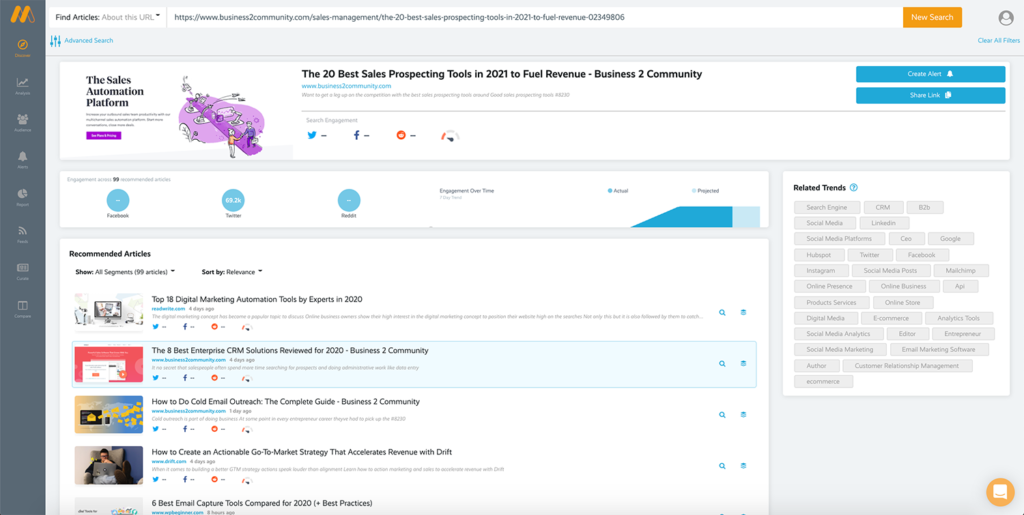
In a moment your results will appear below the search bar, starting with details of the URL you searched, followed by the social buzz on all the discovered articles, and the list of articles under that.
Browse the articles and assess the quality of your search results. If the articles returned aren’t extremely relevant, you may need to refine your results with Advanced Search.
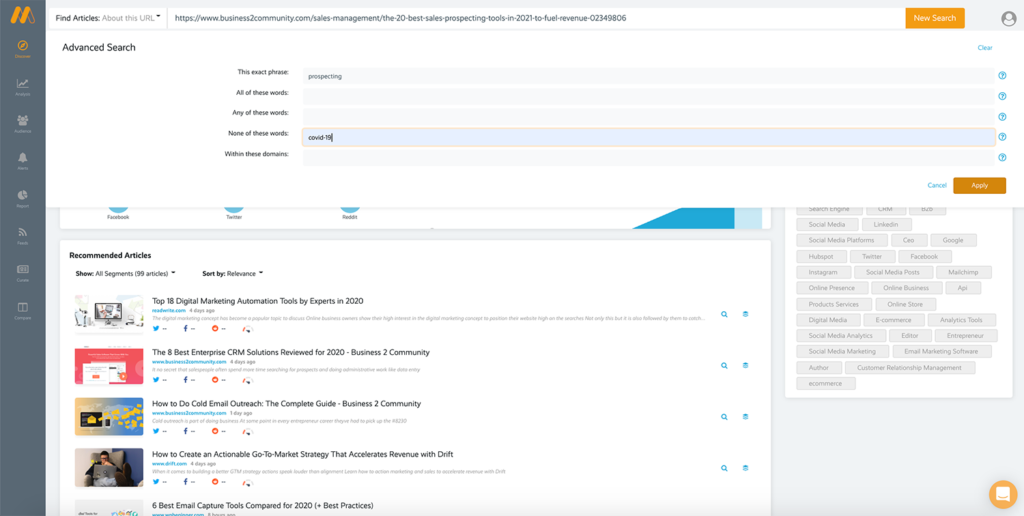
Use Advanced Search to require or filter terms and domains and combine criteria to create complex boolean searches.
Once you’re satisfied with your results, save the search as an alert to be notified when new similar content is published (that meets your criteria). Subscribe to alerts via email (daily) or Slack (hourly) and toggle them on and off as needed.
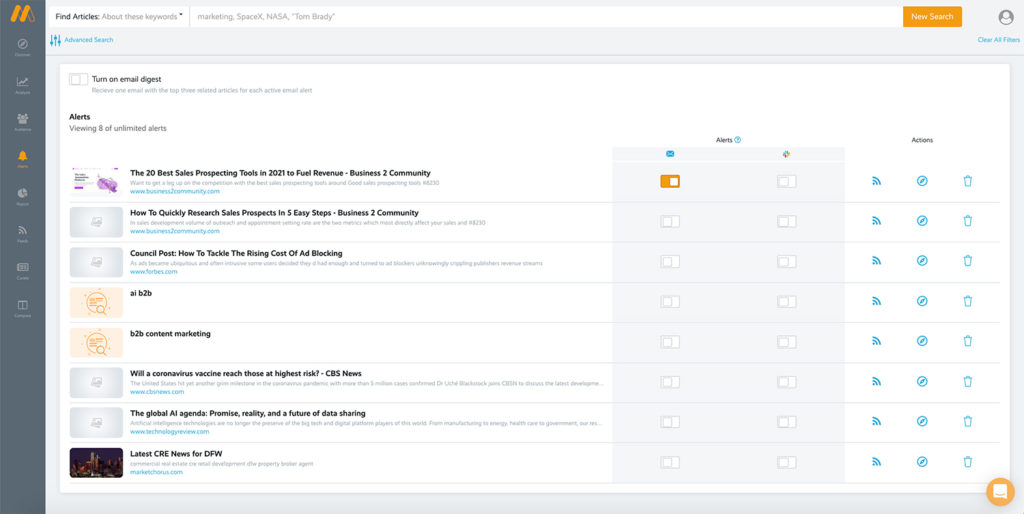
When you’re tracking all the latest news on a given topic, you can wait for the information to come to you and prioritize creating content about the subject matter that presents itself.

Tracking multiple topics of interest virtually guarantees that there’ll always be something to write about; either by providing context or commentary.

Saving Web Clips
If you’re making progress with research you’ll have no shortage of data that needs to be stored for later use.
Taking notes is time consuming and inefficient. Saving clips of content digitally so that you have it on file is revolutionary by comparison.
Evernote is one of the best solutions for saving useful tidbits of information you discover while doing research for blog posts. It’s simple to use and has been around a long time, so you can trust it will still be around when you need to reference your notes.
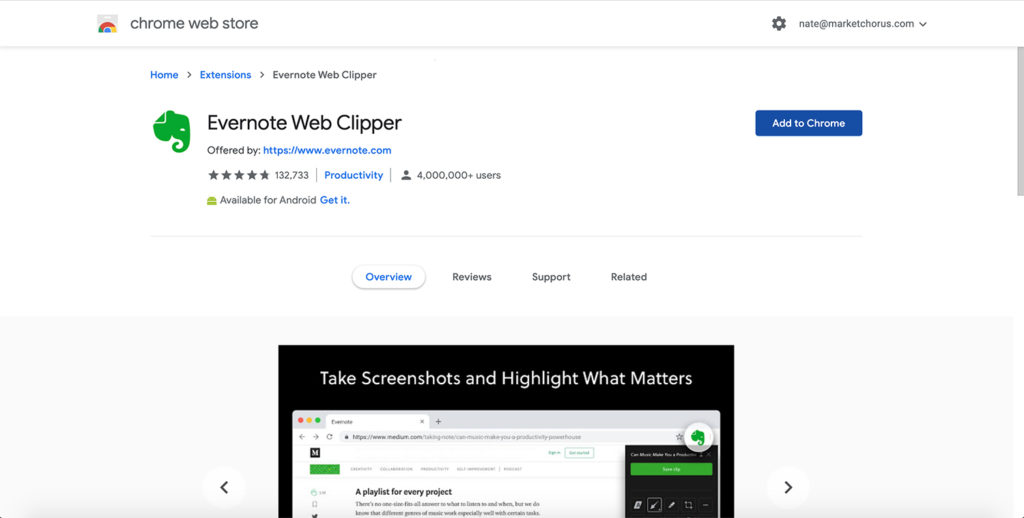
The idea is simple; find a useful bit of information on a web page and use the Evernote Chrome extension to save it to your Evernote account (sign up for a free Evernote account).
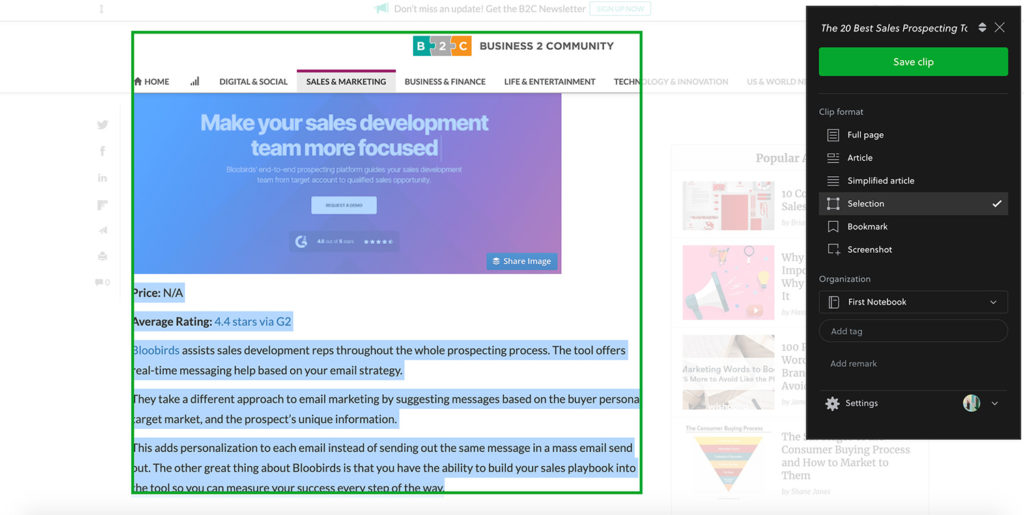
The idea is to always be researching, rather than to have to sit and grind out a large body of work all at once.
Using MarketChorus Resonance in combination with Evernote allows you to turn the active effort of researching into a semi-passive one, saving any useful bits of information you discover with Resonance with Evernote for safekeeping.
After you’ve compiled a wealth of information on potential subject material, you can scan through your trove of data looking for unique insights to share or opportunities to provide context.
Not only will you have a pile of subject matter to choose from, but you’ll also have a wealth of quotes and statistics you can reference. Still, once you’ve found a thread to follow, you’ll most likely still need to flesh out your material with additional research.

Analyzing Topics & Audiences
To stand out among the competition, you need a unique angle to differentiate your content from other articles that have been written on the same subject.
Start by Googling related terms and reading the top 3-4 articles to get a feel for the competitive content you’ll face for visibility on these topics in search.
Once you’ve researched other blog posts on your topic, use MarketChorus Resonance to identify underexposed subtopics within the subject matter you’re covering.
To do this, first search with an example article that’s closely adjacent to your subject matter.
For example, if our topic was “sales prospecting” we might start with an article on “sales prospecting techniques” and analyze the smaller trends within the results to uncover content opportunities.
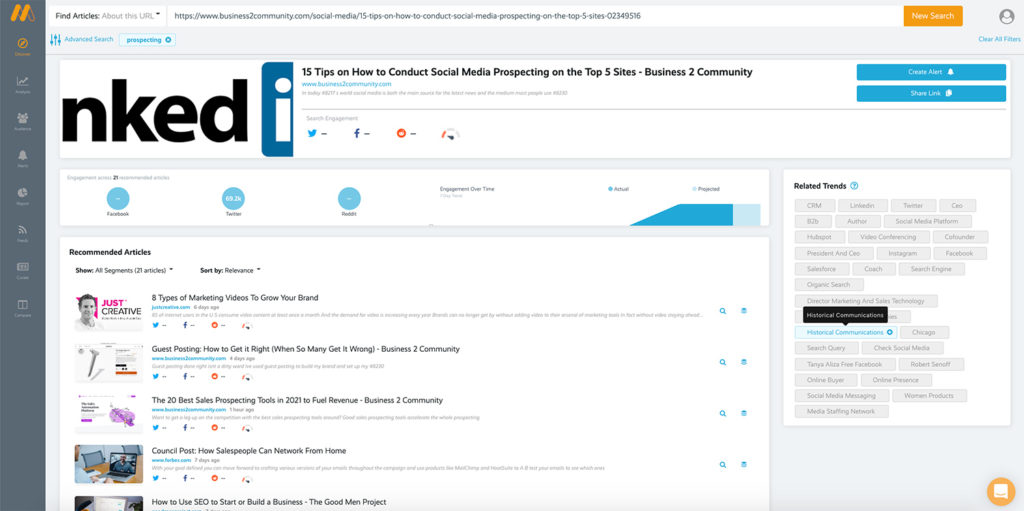
The trends at the top of the list represent topics that have appeared in the most number of related articles.
These terms will always be well-covered by the competition, so look a little further down the list of Related Trends to identify subtopics still worthy of examination.
You can often discover useful bits of information simply by identifying related phrases that you’re not familiar with.
Click on trends you want to know more about to add them to the search criteria. This will bring filter out articles which do not include that phrase from the results.
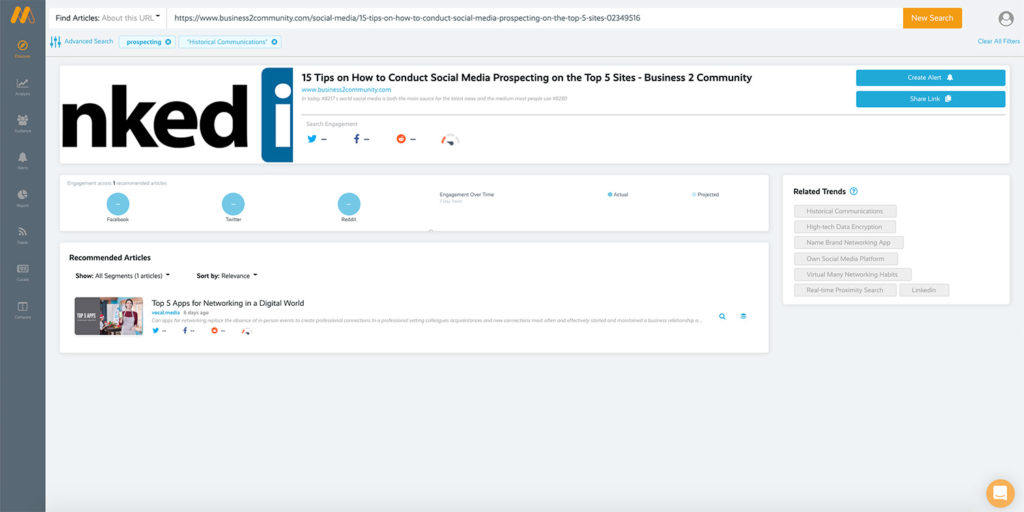
Look for tangential bits of data, not already being widely reported on, that reveal new perspectives and connections that you can explore with your content.
For our example, I was quickly able to find an article with a unique viewpoint that wasn’t already covered by dozens of articles.

We’ve identified an underexposed topic, now we just need a unique perspective from which to provide valuable context to the reader.

With a well defined topic in mind, run searches on all the related articles to mine them for additional insights.
Scan the articles returned by refined searches for useful bits of information you can save as web clips and incorporate into your own content later.
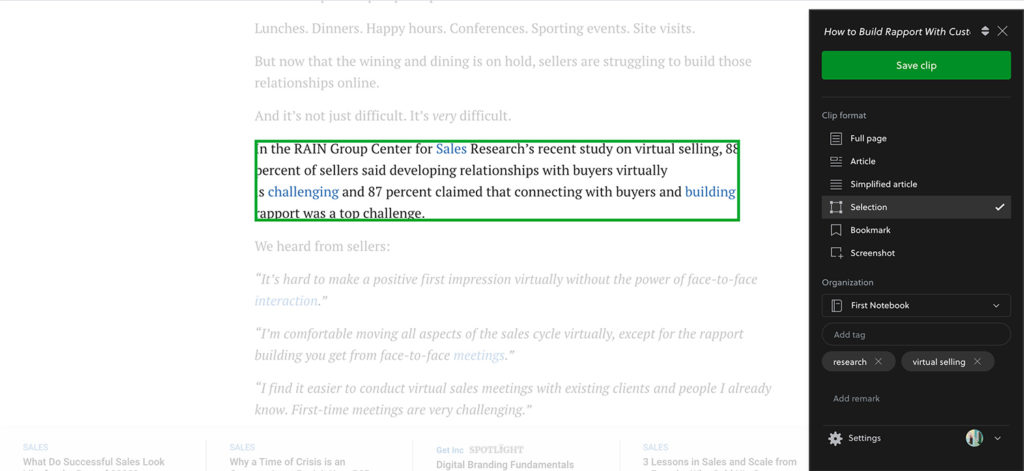
Once you have amassed enough data to fill any gaps in your coverage, all that’s left to do is translate your ideas into words, images, videos, etc.
I often copy/paste the most usable web clips into an empty document and arrange them into a loose narrative outline that I can then fill in easily with good copy.

The value of starting with a treasure trove of good data at your disposal cannot be overstated and it’s well worth the upfront time investment.
But what’s more important is that by taking less time to blog you’re opening the possibility to blog more frequently; and that can have a direct impact on website traffic and lead generation.

Daily Effort Makes Weekly Content An Achievable Goal
The best content creators have great systems and tools for helping them produce quality content at scale. It’s impossible to compete without data-driven insights, helpful automation, and a high degree of interoperability.
Equipping yourself with the tools to succeed is hugely important, but so is the commitment to use them in a way that generates consistent, scalable results –and that requires good habits.
To summarize:
- Reviewing only the most relevant new content on the topics you’re tracking saves you a lot of time you’d otherwise spend searching for the same information.
- Clipping quotes to Evernote quickly with the Chrome extension saves you time copying and pasting, and increases your retention as well.
- Pulling on threads by exploring trends and segments can help you quickly gather a wealth of data to use in the content you create.
Putting it all together, you have a reliable -and fast- system for researching blog posts at scale, on any topic, and keeping it organized without wasting your precious time.
By investing small amounts of time each day you can amass enough information each week to create several pieces of content -and have the time to produce them!
As time goes on, content will only take longer to research, so invest now in good tools and habits that ensure your success in the future.



